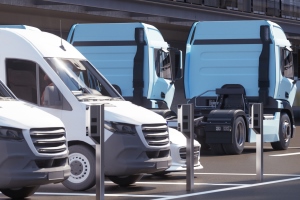Freight in the City opens its doors to showcase the latest commercial vehicles, technology and services for the urban logistics sector. Visitors can expect to see the latest safe, clean delivery vehicles and kit aimed squarely at town and city operations, and talk to manufacturers about their business requirements, say Bernard Magee, director of electric vehicle charging infrastructure at Siemens GB&I and Mark McLoughlin, director Siemens Financial Services
A seamless grid-to-vehicle approach can control energy and capital expenditure costs, simplify managing an EV fleet and deliver vital resilience and reliability.
Planning for a future where you are working with kilowatts rather than litres is a challenge for nearly all fleet operators today. And notably as the pace of change demanded by legislators and expected by customers increases, the costs can appear difficult to quantify with an EV marketplace that is congested with a raft of suppliers.
Questions you may already be asking yourself may be: How much do I to invest, will sites need redesigning and who tracks the energy costs and maintains the EV charging systems?
Transitioning to EV doesn’t have to involve managing a myriad new supplier relationships. And neither does each decision – whether its EV charging systems, the power from the grid, servicing and technical support or finance – need to be taken separately and in the hope that everything ‘connects’ seamlessly.
A grid-to-vehicle approach is an approach that simplifies the changeover and daily operation of an EV fleet and establishes energy efficiency for customers from the outset.
A genuine start-to-finish solution also removes the complexity of managing multiple partners and, just as importantly, ensures that both technology and software solutions complement and communicate with each other.
Know the basics
To begin understanding the electrification process of your fleet it is advisable to start with a discussion about the fleet operations, vehicle types and route schedules then a site survey.
An audit will establish precisely how much power is needed for charging and the actual size of the connections – the ‘grid’ part of the grid-to-vehicle approach.
A thorough evaluation of the connection size will save money and time; overcompensating on the “pipeline” will deliver unnecessary power. And if operating multiple-sites the importance of getting the right amount of power for each location cannot be underestimated.
Charger locations
A logical next step which can be covered by a survey – is the best positioning of the EV charging systems and how it is all connected.

Space is something many depot managers are understandably concerned about. My own colleagues have the know-how to optimise space which is a core part of any installation plan.
Positioning is also key when it comes to avoiding dramatically changing your layout and avoiding expensive redesign work. A partner with power supply expertise can be invaluable.
The speed of charging is paramount and the EV charging management system once operational are all factors that need to be considered.
Does it have the right energy efficiency tools designed for a transport business and will it schedule charges around your timetable or a particular vehicle’s commitments?
The price of electricity
Whatever choice is made regarding EV chargers, a complementary software system to automatically schedule charging when tariffs are lowest and avoiding the requirement to repeatedly charge at expensive peak power levels is worth its weight in gold.
With UK electricity prices fluctuating, how much energy goes into your fleet every working day (and when) is key. It is a cost needing the same scrutiny as fuel and engine parts.
Reliability and service is another major headache for fleet operators. Customers want more than rows of shiny, new chargers. Their wish-list consists of knowing any issues will be resolved quickly and getting ongoing support about controlling energy costs.
The grid-to-vehicle approach ensures customers can be fully supported when the chargers go live with technicians, service packages and advice if a business wants to expand its fleet or operate from a new location.
Financing
How an electric future is financed is often a stumbling block for fleets. Top of the agenda will be concerns over spending too much hard-won capital or whether lease deals are flexible and represent value for money.
Siemens Financial Services has created a range of leasing and payment solutions for equipment and support which customers are benefiting from.
An EV future should see customers being able to access the same wide range of financial resources and advice they presently receive: While the technology and way of working starts to be different, the need to offer the right financial tools remains unchanged. There are turnkey leasing and purchasing solutions as well as tailored individual solutions for larger operations. The ability to provide the right financial products completes the grid-to-vehicle approach.


It’s humbling to think that one of the first purely electric cars was built by Siemens Schuckertwerke over 120 years ago and since then, step by step, we have electrified our world. From planning, engineering, installation, operation, and continuous optimisation, Siemens has been at the forefront of smart electrification, aiming to transform everyday energy use to keep your site resilient, efficient and sustainable.
Bernard Magee and Mark McLoughlin will be speaking at the ‘Electric Unplugged’ seminar from 11.45-12.45 at the Freight in the City event. Siemens is offering free Charging Surgeries throughout the day where you can discuss your EV challenges, talk through the end-to-end process of building your infrastructure, EV fleet and finance options with their experts. They are also demonstrating their high-performance chargers and complementary software solutions. Book your free ticket to attend today!
The authors are Bernard Magee, director of electric vehicle charging infrastructure at Siemens GB&I and Mark McLoughlin,director Siemens Financial Services.
Comment on this article below or via Twitter: @IoTNow_OR @jcIoTnow










